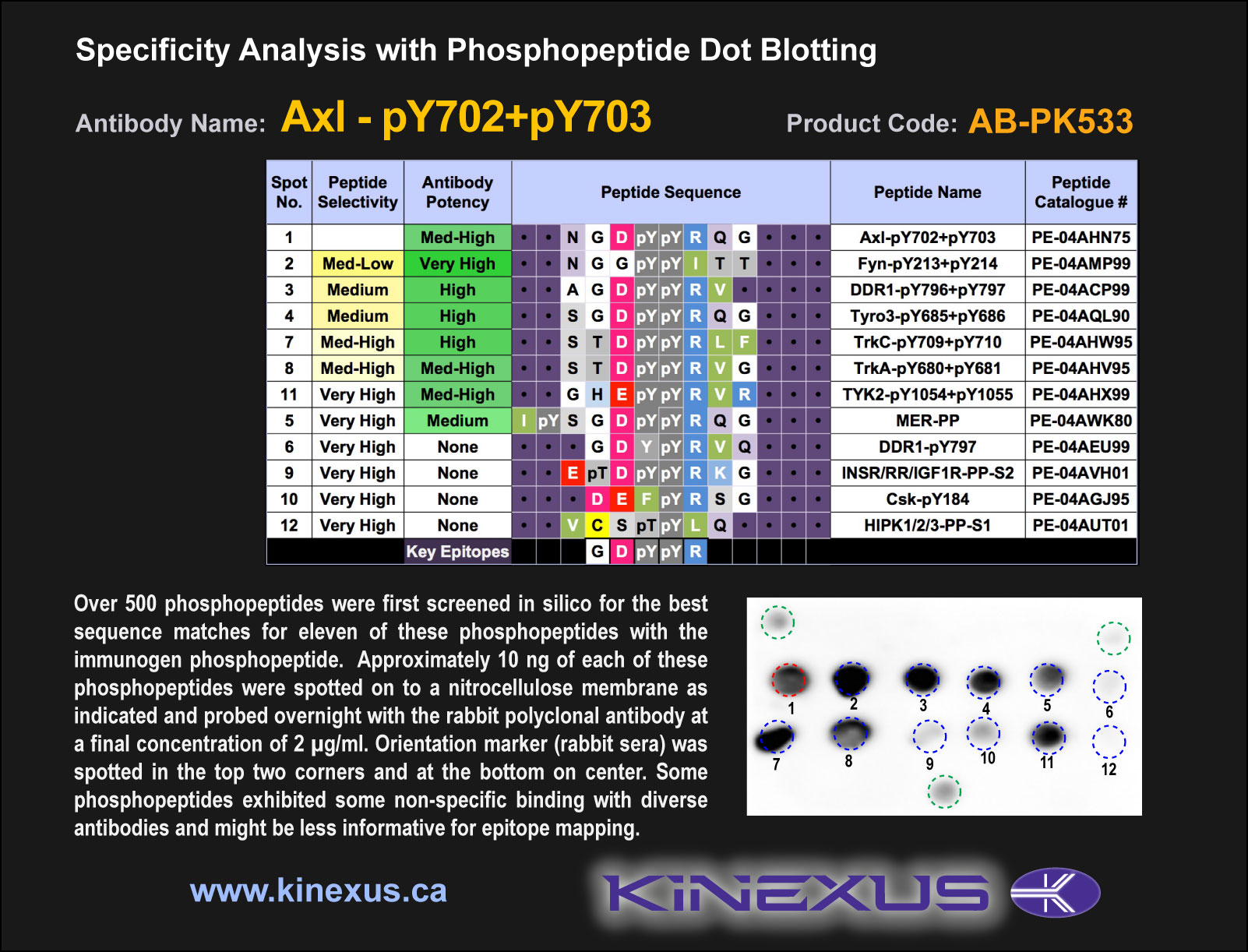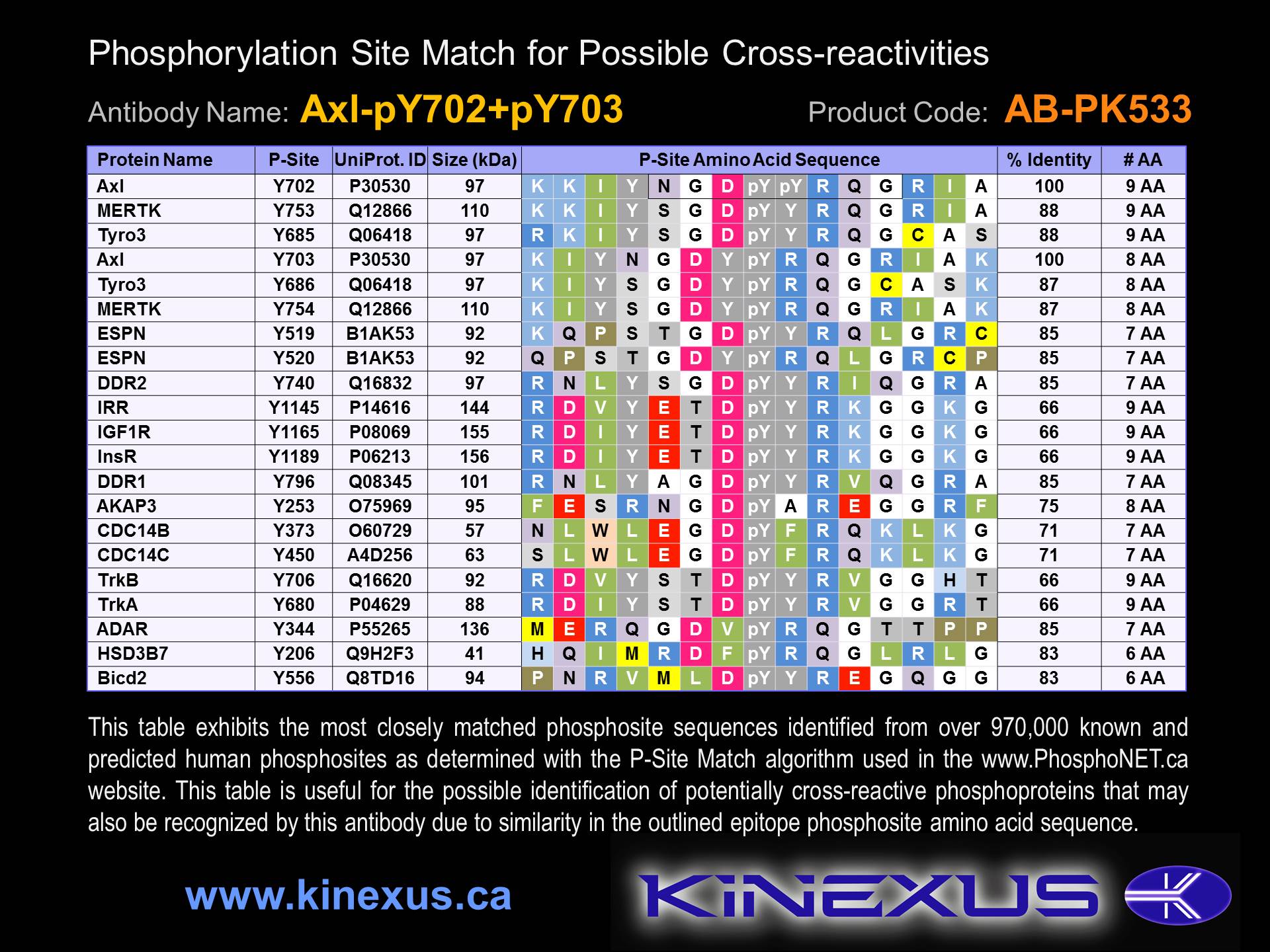Product Name: Axl-pY702+pY703
Product Number: AB-PK533
| Size: | 25 µg | Price: | 89.00 | |
| $US |
Target Full Name: AXL oncogene-encoded protein-tyrosine kinase UFO
Target Alias: Adhesion-related kinase; ARK; AXL oncogene; AXL receptor tyrosine kinase; JTK11; Kinase AXL; UFO; CCDS12574.1; ENSG00000167601; Q15839
Product Type Specific: Protein kinase phosphosite-specific antibody
Antibody Code: PK533
Antibody Target Type: Phosphosite-specific
Antibody Phosphosite: Y702+Y703
Protein UniProt: P30530
Protein SigNET: P30530
Antibody Type: Polyclonal
Antibody Host Species: Rabbit
Target Alias: Adhesion-related kinase; ARK; AXL oncogene; AXL receptor tyrosine kinase; JTK11; Kinase AXL; UFO; CCDS12574.1; ENSG00000167601; Q15839
Product Type Specific: Protein kinase phosphosite-specific antibody
Antibody Code: PK533
Antibody Target Type: Phosphosite-specific
Antibody Phosphosite: Y702+Y703
Protein UniProt: P30530
Protein SigNET: P30530
Antibody Type: Polyclonal
Antibody Host Species: Rabbit
Antibody Immunogen Source: Human Axl (UFO) sequence peptide Cat. No.: PE-04AHN75
Antibody Immunogen Sequence: NGD(pY)(pY)RQG(bA)C
Antibody Immunogen Description: Corresponds to amino acid residues N699 to G706; In protein kinase catalytic domain activation T-loop between subdomains VII and VIII.
Antibody Immunogen Sequence: NGD(pY)(pY)RQG(bA)C
Antibody Immunogen Description: Corresponds to amino acid residues N699 to G706; In protein kinase catalytic domain activation T-loop between subdomains VII and VIII.
Production Method: The immunizing peptide was produced by solid phase synthesis on a multipep peptide synthesizer and purified by reverse-phase hplc chromatography. Purity was assessed by analytical hplc and the amino acid sequence confirmed by mass spectrometry analysis. This peptide was coupled to KLH prior to immunization into rabbits. New Zealand White rabbits were subcutaneously injected with KLH-coupled immunizing peptide every 4 weeks for 4 months. The sera from these animals was applied onto an agarose column to which the immunogen peptide was thio-linked. Antibody was eluted from the column with 0.1 M glycine, pH 2.5. Subsequently, the antibody solution was neutralized to pH 7.0 with saturated Tris.This antibody was also subject to negative purification over phosphotyrosine-agarose.
Antibody Modification: Unconjugated. Contact KInexus if you are interest in having the antibody biotinylated or coupled with fluorescent dyes.
Antibody Modification: Unconjugated. Contact KInexus if you are interest in having the antibody biotinylated or coupled with fluorescent dyes.
Antibody Concentration: 1 mg/ml
Storage Buffer: Phosphate buffered saline pH 7.4, 0.05% Thimerasol
Storage Conditions: For long term storage, keep frozen at -40°C or lower. Stock solution can be kept at +4°C for more than 3 months. Avoid repeated freeze-thaw cycles.
Product Use: Western blotting | Antibody microarray
Antibody Dilution Recommended: 2 µg/ml for immunoblotting
Antibody Species Reactivity: Human
Antibody Positive Control: The observed molecular mass of the processed target protein on SDS-PAGE gels is reported to be around 95-105 kDa.
Antibody Specificity: High-very high
Storage Buffer: Phosphate buffered saline pH 7.4, 0.05% Thimerasol
Storage Conditions: For long term storage, keep frozen at -40°C or lower. Stock solution can be kept at +4°C for more than 3 months. Avoid repeated freeze-thaw cycles.
Product Use: Western blotting | Antibody microarray
Antibody Dilution Recommended: 2 µg/ml for immunoblotting
Antibody Species Reactivity: Human
Antibody Positive Control: The observed molecular mass of the processed target protein on SDS-PAGE gels is reported to be around 95-105 kDa.
Antibody Specificity: High-very high
Antibody Cross Reactivity: No significant cross-reactive proteins detected in HEK-293 cells, except for weak 78, 130 and 140 kDa proteins (could be target).
Related Product 1: Axl-pY702+pY703 blocking peptide
Related Product 2: Axl-AKCD pan-specific antibody (Cat. No.: AB-NK010-2)
Related Product 3: AxlSubtide - Axl protein kinase substrate peptide
Related Product 4: IRS1 (979-989) KinSub - Insulin receptor substrate 1 (K979-G989, mouse) peptide; Insulin receptor substrate
Related Product 1: Axl-pY702+pY703 blocking peptide
Related Product 2: Axl-AKCD pan-specific antibody (Cat. No.: AB-NK010-2)
Related Product 3: AxlSubtide - Axl protein kinase substrate peptide
Related Product 4: IRS1 (979-989) KinSub - Insulin receptor substrate 1 (K979-G989, mouse) peptide; Insulin receptor substrate
Scientific Background: Axl (UFO) is a protein-tyrosine kinase of the TK group and Axl family. It is a receptor kinase for its ligand growth arrest-specific gene-6 (GAS6), which is a growth factor that drives cell proliferation. GAS6 is a vitamin K-dependent protein structurally similar to Protein S (PROS1), which activates MERTK and TYRO3 but not Axl. The extracellular domain contains six N-linked glycosylation sites,and this generates two other post-translationally modified forms of 120 and 140 kDa represent partial and complete glycosylation, respectively. Phosphorylation of Y821 induces interactions with Grb2, PIK3R1, PIK3R2, and PLCG1.Some of Axl signalling pathways involve PI3K/Akt, Ras and ERK MAP kinases. It regulates cell survival and proliferation, preventing apoptosis, migration, cell adhesion, cell aggregation and homophillic binding. Mutation of Axl at E63R, E66R, and T84R reduces its affinity for GAS6. Axl is expressed most tissue and cell types, with highest in endothelial cells, heart and skeletal muscle, liver, kidney, testis, platelets, myelomonocytic cells, hippocampus, and cerebellum. Axl is overexpressed in numerous human cancers, including thyroid carcinomas, myeloproliferative disorders, prostatic carcinoma cells, and breast cancer. Its up-regulation in expression contributes to metastasis and invasion, and in most cases negatively correlates with prognosis.
Figure 1. Epitope mapping of Axl-pY702+pY703 antibody with similar phosphopeptides on dot blots.
Figure 2. Identification of phosphosites related to Axl-pY702+pY703.
© Kinexus Bioinformatics Corporation 2017



